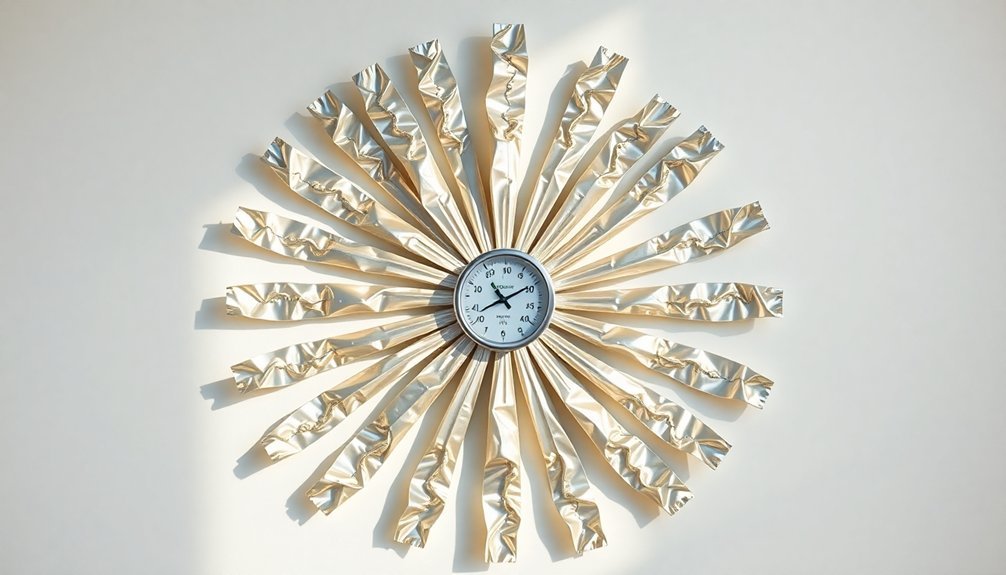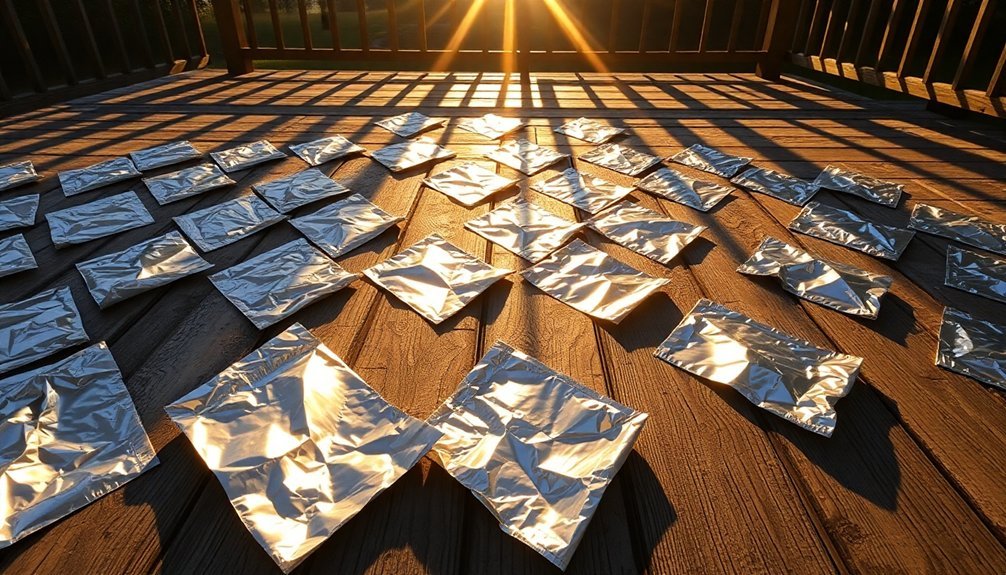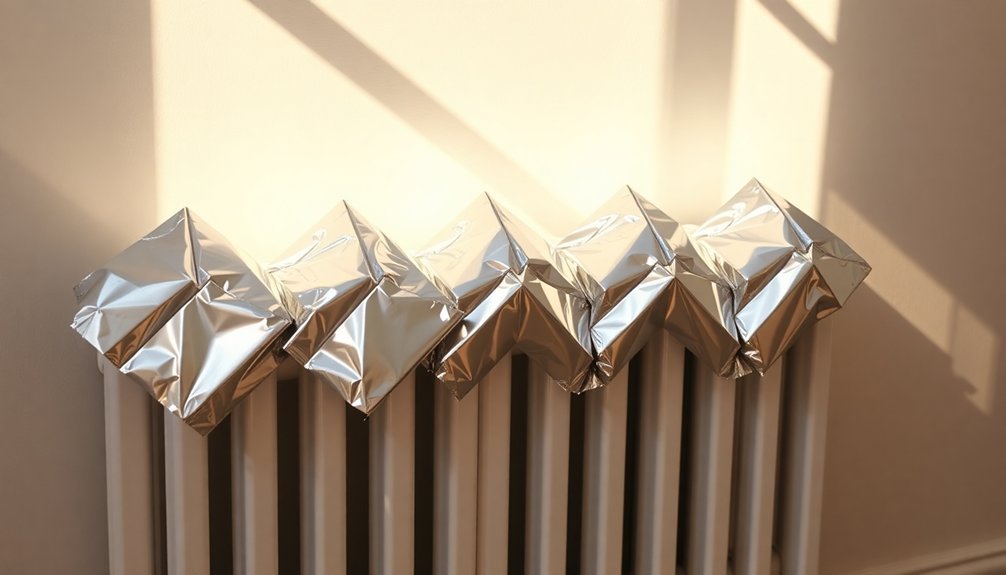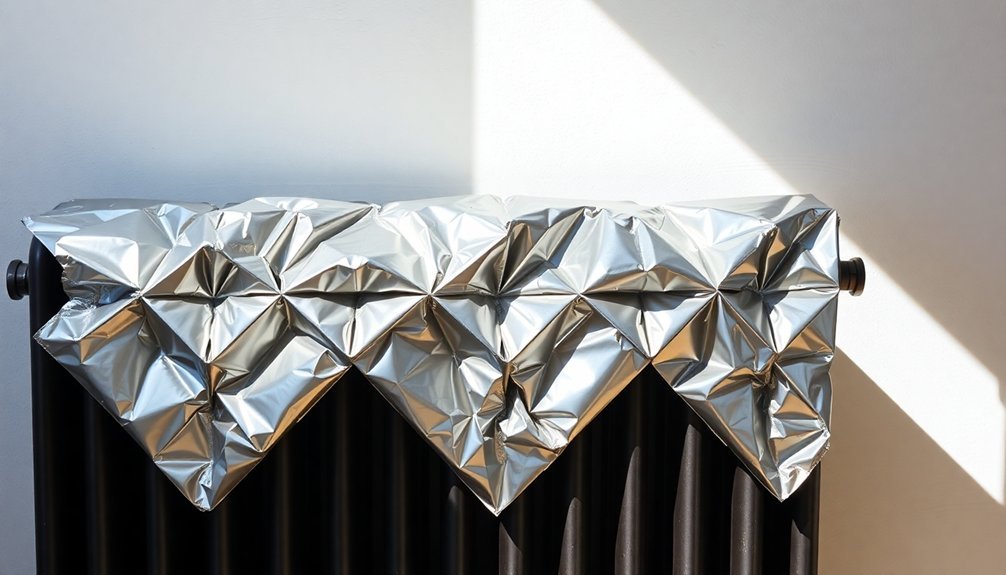To maximize heat with aluminum foil patterns, you'll want to position your foil perpendicular to the heat source with the bright side facing it. Create smooth, unwrinkled surfaces and overlap sheets by at least 1/2 inch, securing edges with heat-resistant tape. You can achieve 94% heat retention using diagonal patterns in winter, while horizontal patterns reflect 95% of heat in summer. Maintain air spaces between foil layers to reduce heat transfer and allow controlled air movement. Keep surfaces dust-free and properly spaced for ideal reflection. These foundational techniques are just the beginning of mastering efficient heat distribution with foil.
Understanding Basic Reflection Principles

When you're working with aluminum foil to maximize heat, understanding the basic principles of reflection is crucial. The process follows two key laws: the incident ray, reflected ray, and normal all exist in the same plane, and the angle of incidence equals the angle of reflection.
You'll notice that when heat or light hits the foil (incident ray), it bounces off (reflected ray) at the exact same angle from which it came. This reflection happens perpendicular to the surface at the point of contact, following an imaginary line called the normal.
Since both sides of aluminum foil are equally effective at reflection, you don't need to worry about which side faces the heat source. These principles guarantee that heat energy is conserved during reflection, making foil an efficient heat management tool. The foil's smooth surface creates specular reflection, ensuring consistent and predictable heat distribution.
Materials and Preparation Steps
Success with aluminum foil projects hinges on choosing the right materials and following proper preparation steps.
You'll need quality aluminum foil, appropriate base fabrics like fiberglass or Kevlar, and reliable adhesives for bonding layers together. For enhanced durability, consider using a 3-way fiberglass scrim as reinforcement. The aluminum foil used can reflect up to 97% of radiant heat when properly installed.
When preparing laminated or coated surfaces, you'll want to match the thickness to your specific needs. Thicker layers offer better abrasion resistance, while thinner coatings provide more flexibility.
If you're creating specialized shapes, you can compact and polish the foil using aluminum polish for a more reflective finish.
Remember that proper installation requires maintaining an air space near the reflective surface and keeping it dust-free for maximum effectiveness.
Select the appropriate grade based on your project's requirements.
Optimal Foil Positioning Methods

Proper foil positioning can make or break your heat management results. When working with aluminum foil, you'll want to angle it perpendicular to your heat source for maximum reflection. Keep the bright side facing the direction you want concentrated heat, as it offers superior specular reflectivity. Similar to how strategic placement creates dimension in hair foiling techniques, precise positioning of cooking foils ensures optimal results.
For ideal heat management, consider these key positioning strategies:
- Maintain smooth, unwrinkled surfaces to enhance reflection efficiency
- Create an appropriate gap between the foil and heat source to prevent overheating
- Add strategic ventilation holes when necessary to manage steam buildup
If you're using non-stick foil, remember that the non-stick side should always face your food, though this won't affect heat reflection.
For high-heat applications, choose heavy-duty foil and verify it's securely positioned to prevent shifting during cooking.
Heat Distribution Engineering
Understanding heat distribution engineering requires mastering three fundamental mechanisms: conduction, convection, and radiation. When you're working with aluminum foil, you'll need to take into account how these processes interact to maximize heat efficiency.
Despite aluminum's low thermal conductivity, its high reflectivity makes it excellent for controlling radiant heat. You'll get the best results by creating air spaces between foil layers, as this reduces conductive heat transfer while maximizing reflective properties. Regular maintenance to remove stagnant product films through cleaning will help maintain optimal heat transfer efficiency.
For convective heat management, guarantee proper spacing to allow controlled air movement where needed.
To optimize your heat distribution system, you'll want to examine surface properties carefully. Position the foil's reflective surface toward the heat source you're trying to control, and maintain clean, unwrinkled surfaces to preserve its effectiveness at redirecting thermal radiation.
Maximizing Solar Energy Collection

When maximizing solar energy collection with aluminum foil, you'll need to integrate several key technologies and techniques. Using an MPPT controller is essential for enhancing performance in low-light conditions, as it'll automatically adjust voltage for peak efficiency.
Your system's effectiveness depends on these critical components:
- High-efficiency monocrystalline panels that perform better in cloudy conditions
- Battery storage systems to retain excess energy for low-light periods
- Adjustable mounting brackets for seasonal angle enhancement
You'll want to adjust your panel angles seasonally, using steeper tilts during winter months when the sun sits lower in the sky.
When combined with aluminum foil reflectors, these enhancement methods considerably boost your system's energy collection capacity, especially during challenging weather conditions.
The MPPT controller will help maintain peak performance by continuously finding the ideal power point.
Common Pattern Design Techniques
To maximize heat reflection, you'll want to position your aluminum foil sheets in overlapping layers that provide complete coverage without gaps or exposed areas.
When creating these patterns, guarantee each foil sheet overlaps the adjacent one by at least 1/2 inch, securing the edges with heat-resistant tape to prevent shifting.
You can enhance reflection efficiency by installing the foil at strategic angles that direct heat toward your desired zones, particularly in corners and around heat sources where maximum reflection is essential.
Strategic Placement for Coverage
Proper placement of aluminum foil requires strategic pattern designs for maximum heat control and efficiency. When applying foil to windows, verify it's smooth and wrinkle-free on the sun-facing side to optimize heat reflection during summer months.
For equipment protection, wrap the foil closely around heat-exposed areas, paying special attention to complex or hard-to-reach spots.
To maximize coverage effectiveness, you'll want to:
- Secure the foil firmly to prevent shifting or peeling
- Remove all wrinkles for even heat distribution
- Cover all exposed surfaces completely
For indoor applications, position the foil to reflect heat back into living spaces during winter.
Whether you're working on machinery or home projects, crumpled foil can be molded to fit intricate shapes, making it versatile for various coverage needs.
Overlapping Foil Layer Techniques
Effective overlapping techniques form the foundation of successful foil installation. When laying your foil sheets, maintain a minimum 1 cm overlap between pieces, ensuring you're creating a continuous barrier against heat or moisture.
Always position the overlaps in the direction of expected heat or moisture flow for ideal protection.
You'll want to check each overlapped section carefully for gaps or wrinkles that could compromise your insulation. Reinforce these joints with aluminum tape that matches your foil's properties, smoothing it carefully to prevent air bubbles.
As you work, align all edges precisely with any end plates or supports, and trim excess material using a sharp cutting tool. Remember to keep edges clean and debris-free before joining them, as this helps create the snug, uniform layer you're aiming for.
Angled Reflection Zone Creation
Creating strategic reflection zones with aluminum foil requires careful attention to surface characteristics and pattern designs.
You'll want to work with the foil's bright side for maximum specular reflectivity, which delivers 2% more power in concentrated zones.
To create effective angled reflection patterns:
- Press the foil into specific hills and valleys using embossing techniques for controlled light direction
- Smooth surfaces to maintain roughness under 100 nm for ideal UV reflection
- Use crumpling and flattening methods to achieve uniform diffuse reflection where needed
When designing your reflection zones, consider the incident light angle, as it affects both total and diffuse reflectivity.
You can enhance the reflection pattern by using tools like pencil erasers to refine embossed areas, ensuring precise light distribution for your heating needs.
Temperature Control Through Pattern Placement

The strategic placement of aluminum foil patterns can dramatically influence a room's temperature control capabilities. You'll maximize efficiency by arranging foil in specific configurations that create ideal reflection zones. By installing patterns that direct heat where you need it most, you can reduce energy costs while maintaining comfort.
| Pattern Type | Best Use | Efficiency Rate |
|---|---|---|
| Diagonal | Winter Warmth | 94% Heat Retention |
| Horizontal | Summer Cooling | 95% Heat Reflection |
| Vertical | UV Protection | 90% Light Control |
To achieve the best results, you'll want to leave air spaces between the foil and surfaces. If you're working with flexible areas, use aluminum-coated film fiberglass, while static applications benefit from foil-coated fiberglass sleeves. Remember to take into account the weight of your chosen material – 21oz for standard use and 35oz for heavy-duty applications.
Testing and Performance Measurement
Three key components form the foundation of reliable foil insulation testing: a stainless steel screen setup, precise measurement techniques, and controlled environmental conditions.
You'll find the testing apparatus uses water-cooled copper plates with a vertical screen to simulate standard wall cavities.
When measuring performance, you need to evaluate:
- R-value changes across temperature differences (10°F to 50°F)
- Heat transfer through parallel paths
- Emissivity variations due to corrosion
You'll want to note that R-values typically decrease by 20-40% as temperature differences increase.
The accuracy of these measurements reaches ±10% in most conditions, though it's less reliable at very low temperature differences.
Three-foil products outperform two-foil versions, but both fall short of mineral-fiber batts in overall insulation effectiveness.
Frequently Asked Questions
Can Aluminum Foil Patterns Increase Fire Risk When Used Near Heat Sources?
Yes, you'll create serious fire risks if you place aluminum foil patterns near heat sources. The foil can conduct electricity, generate heat, and reflect thermal energy, potentially igniting nearby flammable materials.
How Often Should Aluminum Foil Reflection Patterns Be Replaced for Optimal Performance?
You should replace your aluminum foil reflection patterns every 3-6 months or when you notice visible damage, scratches, or discoloration. Don't wait until the foil's completely degraded as this reduces its reflective effectiveness.
Do Weather Conditions Affect the Durability of Outdoor Aluminum Foil Installations?
Yes, but you'll find aluminum foil highly weather-resistant. It'll withstand temperatures from -30°C to 80°C, resist moisture, UV rays, and wind. You should only need to replace it if physical damage occurs.
What Maintenance Is Required to Keep Reflection Patterns Clean and Effective?
You'll need to regularly dust and gently clean your foil surfaces with mild solutions, inspect for scratches or damage, and avoid touching patterns directly. Keep surfaces protected from moisture and environmental contaminants.
Can Aluminum Foil Patterns Interfere With Wireless Signals or Electronic Equipment?
Yes, your aluminum foil patterns can interfere with Wi-Fi and electronic signals. They'll reflect or block wireless transmissions, potentially disrupting connectivity. You'll need to carefully position them away from routers and electronic devices.
In Summary
You've learned how to harness heat effectively using aluminum foil reflection patterns. By applying basic principles of light and heat reflection, choosing ideal positioning, and implementing strategic pattern designs, you'll maximize thermal efficiency in your space. Remember to test different configurations and measure results for the best performance. With these techniques, you're now equipped to create energy-efficient heating solutions using simple materials.





Leave a Reply